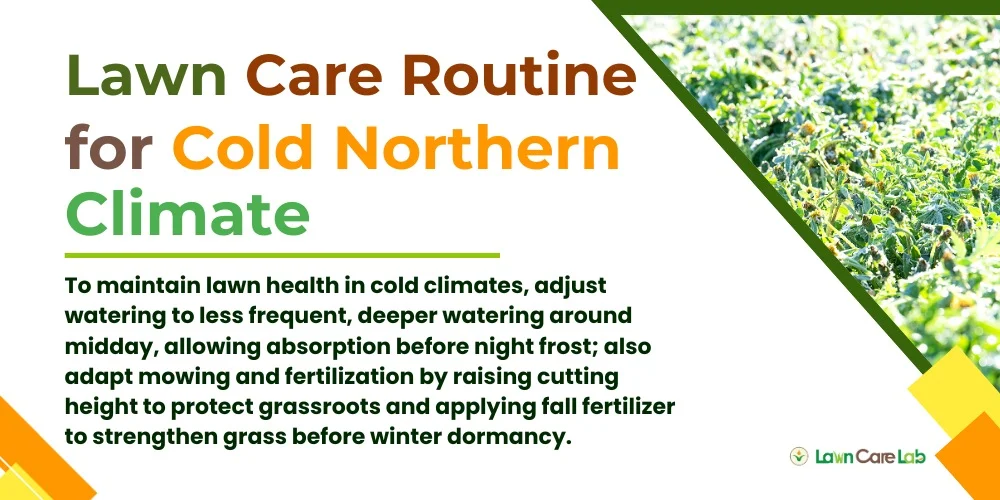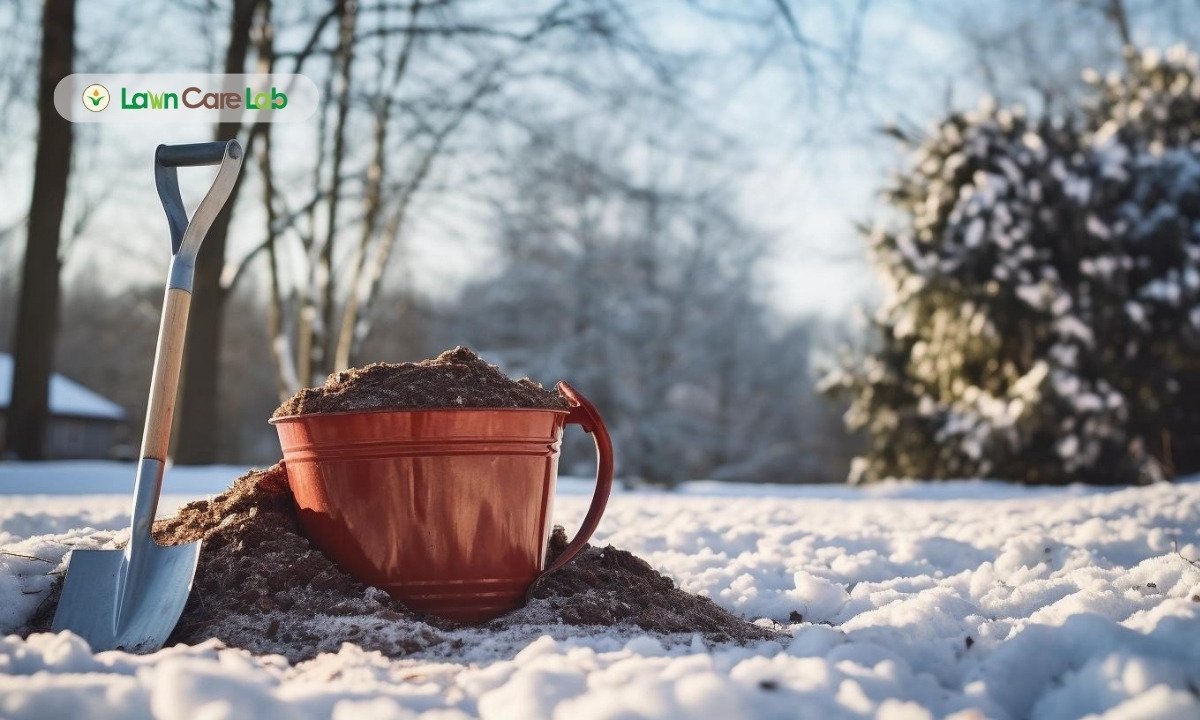Enduring severe winters can be challenging, and your lawn also experiences the icy impact! Maintaining verdant grass in frigid northern climates presents a unique set of obstacles, doesn’t it?
With strategic modifications to your lawn care routine, you can protect your outdoor space from the harshness of winter. We’re here to guide you through the process of how to adapt your lawn care Routine for cold Northern climate, from pre-winter preparation to springtime rejuvenation.
So, let’s get to work and prepare your lawn for the cold Northern climate. Rest assured, a lush, thriving lawn in the cold is a dream and a feasible reality!
Table of Contents
Understanding the Challenges of Cold Northern Climates

Maintaining a healthy lawn in the North’s frigid climate is challenging due to persistent frost, snowfall, and lack of sunlight.
Moreover, the conundrum of soil freezing and nutrient sequestration further complicates the quest for a verdant lawn amidst these austere conditions.
Impact of Frost and Snow on Lawn Health
During winter, frost can cause plant discoloration and death, while snow compacts soil and hinders nutrient flow to roots.
To best navigate these winter-induced impediments, it’s crucial to comprehend their three primary effects:
- Frost-induced damage to grass blades and roots
- Discoloration or demise of grass
- Soil densification under the weight of snow
Dealing with Limited Sunlight Exposure
In frigid northern climates, managing sparse sunlight exposure can be challenging after dealing with frost and snow. Shorter days and weaker solar rays can make your lawn look dull.
Below is a straightforward chart offering practical remedies:
| Dilemma | Origin | Resolution |
|---|---|---|
| Inhibited Grass Growth | Scant Sunlight | Employ cold-enduring grass varieties |
| Faded Hue | Brief Daylight Periods | Administer winter-friendly fertilizer |
| Accumulation of Rubbish | Leaf Shedding | Maintain routine lawn sanitation |
Preventing Soil Freezing and Nutrient Lockup
In the chill of northern climates, the distinct issue of soil freezing and nutrient lockup presents itself.
This phenomenon arises when plummeting temperatures solidify the ground, barricading crucial nutrients and obstructing their path to the grassroots.
Grasping apt strategies to counteract this can serve as the linchpin in preserving a verdant lawn, even amidst the severity of winter.
Key Nutrients for Frozen Soil Conditions
In safeguarding your lawn against the severe conditions of a frosty northern climate, one must appreciate the vital function of potassium and phosphorous in impeding soil freeze and nutrient immobilization.
Potassium fortifies the grass, enhancing resistance to cold and disease.
Phosphorous stimulates robust root development.
Consistent dispersion of these vital nutrients facilitates sustained lawn vitality throughout the rigors of tough winters.
Preparing Your Lawn for the Cold Season
As winter approaches, fortifying your lawn in the fall is important to prepare it for the impending frost.
Importance of Autumn Lawn Care
Appreciating the roles played by fall lawn care can be instrumental in fortifying your outdoor space against the unforgiving winter of the north.
Pivotal undertakings such as aeration, fertilization, and overseeding could significantly bolster the vitality and endurance of your lawn.
Let me elucidate how these indispensable fall activities lay the groundwork for a lush, flourishing lawn when spring returns.
Essential Autumn Lawn Care Tasks
As autumn casts its vibrant hues and chilly winds, certain strategic moves are imperative to fortify your lawn against the imminent northern winter’s icy grip.
- Initiate with a thorough sweep of the fallen leaves, preventing the undergrowth’s suffocation.
- Progress by aerating the earth, a process enhancing the soil’s capacity for nutrient assimilation.
- Conclude your efforts by administering a potent winterized fertilizer, thus bolstering root resilience.
Adherence to these procedures promises to maintain your lawn’s health and vitality, even in the face of frosty adversity.
Adapting Your Lawn Care Routine for Cold Northern Climate

Adjusting your lawn care routine for colder months can improve your lawn’s health and appearance. This involves tweaking irrigation, mowing, and fertilization methods.
Let’s explore these aspects to help you sustain a verdant, robust lawn, irrespective of the climatic conditions.
Adjusting Watering Practices
To adapt your lawn care to colder climates, revise your irrigation techniques. Focus less on frequent moisture application and ensure water penetrates deeply to nourish roots.
Learn optimal hydrating times to protect your turf from harm.
Best Times to Water in Cold Climates
To keep your lawn healthy in cold weather, water it around noon so the moisture can seep into the soil before the night’s frost.
To elaborate:
- Absorption: Initiate watering at noon to maximize the soil’s moisture retention.
- Temperature: The relative warmth during midday thwarts immediate freezing.
- Timing: Late watering could instigate overnight freezing, harming your lawn’s health.
Protecting Your Lawn from Winter Damage
Transitioning into the winter season necessitates a proactive approach to safeguard your lawn from the adverse impact of cold weather.
Poorly managed snow accumulations may lead to snow mold, a detrimental fungal disease that can severely damage your lawn following the snow’s retreat.
Furthermore, the strategic execution of pest control measures and the judicious selection of winter-specific lawn care products are robust defenses against the winter’s severity.
Managing Snow Piles and Preventing Snow Mold
Managing snow accumulations and preventing snow mold is crucial to protect your lawn from suffocation and harmful pests.
Here are some expert strategies:
- Disperse Snow Equitably: Distribute snow evenly on your lawn to avoid burden and moisture build-up in one spot.
- Eliminate Surplus Snow: Regularly excavate significant snow deposits to diminish the potential of suffocating your grass.
- Meticulous Fall Lawn Maintenance: Thorough fall aeration, dethatching, and fertilization can help prevent snow mold.
Spring Lawn Recovery after Heavy Winters
The advent of spring heralds an essential period for assessing your lawn’s health, particularly after enduring the rigors of winter.
Before spring recovery, assess your lawn’s current state to identify problem areas and plan rejuvenation strategies.
Evaluating Lawn Health Post-Winter
As the winter’s icy grasp relinquishes control, it becomes paramount to thoroughly examine your lawn to discern any harm inflicted by the biting cold.
Be vigilant for indications of distress, such as sparse patches, discolored zones, or the likely presence of disease or pest intrusion.
Prompt detection of these complications will aid in formulating an efficacious strategy for spring lawn rejuvenation.
Identifying Signs of Lawn Stress
Check your lawn thoroughly after winter for signs of stress like yellowing grass, bare patches, pests, and diseases.
- Chromatic Aberrations: Be vigilant for regions where the grass exhibits a shift in color, transforming to yellow or brown.
- Decline in Grass Density: Identify locations where the grass appears scanty.
- Pests or Disease: Scrutinize for the existence of insects, fungi, or other manifestations of disease.
Expert Tips to Maintain a Healthy Lawn Year-Round in Cold Climates
The secret to maintaining a verdant lawn, even amidst frigid climates, is adhering to a few key strategies.
Commence with pinpointing the perfect grass species suited for your unique climatic conditions.
Follow this up with a steadfast commitment to consistent lawn care and a swift response to variable weather patterns and severe climatic shifts.
This approach will guarantee a flourishing lawn irrespective of the season.
Choosing the Right Grass Variety
To maintain a healthy lawn in colder climates, select a grass variety that can endure harsh, freezing temperatures throughout the year. Not all grass varieties can withstand such conditions.
Let’s consider three varieties particularly adapted to these conditions:
- Kentucky Bluegrass: Known for its resilience, this variety tolerates freezing temperatures well.
- Ryegrass: This fast-germinating variety acts as a protective shield against winter damage to your lawn.
- Fescues: These are robust grasses requiring minimal upkeep, thereby rendering them an outstanding selection for chillier climates.
Selecting an appropriate grass variety sets you on the journey to a verdant, healthier lawn.
Regular Lawn Maintenance Tasks
To maintain a healthy lawn in a cold climate, follow a consistent regimen of mowing, watering, aerating, and fertilizing adjusted to the changing seasons.
Aerate soil for better water and nutrient flow. Remove dead grass and debris by dethatching for healthier growth. Prioritize safety when handling tools and chemicals.
As you cultivate your lawn, responding to shifts in climate and severe weather phenomena is vital, a subject we’ll investigate in the subsequent section.
Adapting to Climate Changes and Extreme Weather Events
To safeguard your lawn’s vitality, heed these professional recommendations:
- Enrich Your Understanding: Continually augment your comprehension of emerging grass species, lawn care commodities, and strategies to tackle weather extremities.
- Opt for Weather-Tolerant Grass: Certain grass species exhibit superior resilience to rigorous conditions. Opt for a variety that aligns with your regional climate.
- Equip Your Lawn for Winter: Ensure your lawn’s survival through winter by aerating, fertilizing, and applying a winterizer in late autumn.
Conclusion
To have a flourishing lawn in frosty northern climates, prepare well, care consistently, and protect robustly.
It’s imperative to remember that success hinges on your ability to strategize and foresee. Initiate your springtime lawn rejuvenation as soon as possible and ensure that you incorporate professional advice for comprehensive, year-round maintenance.
By doing so, you’ll relish the sight of a resplendent, verdant lawn, undeterred by the weather.
- How to Create a Lawn Care Schedule for Southern Climates - October 30, 2024
- How to Use Compost Tea to Boost Lawn Growth and Soil Health - October 23, 2024
- The Best Grasses for Saltwater-Exposed Lawns: Coastal Lawn Care - October 17, 2024




